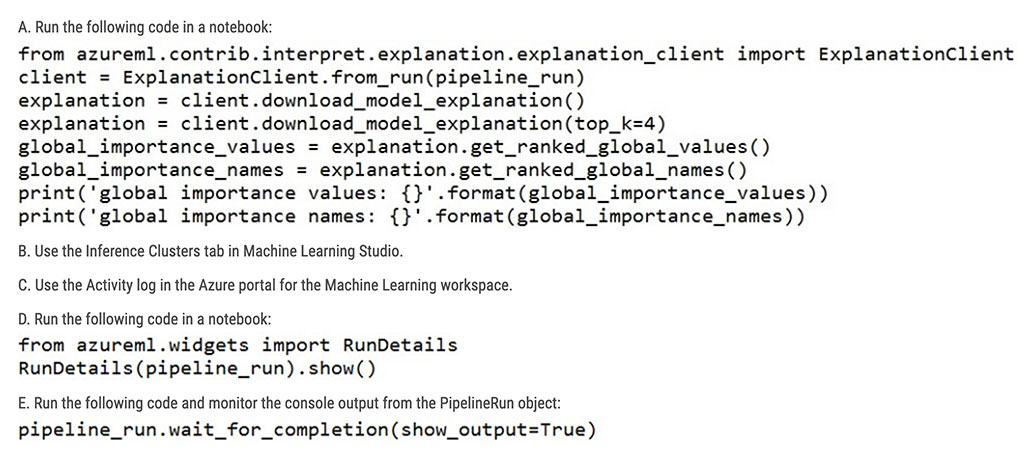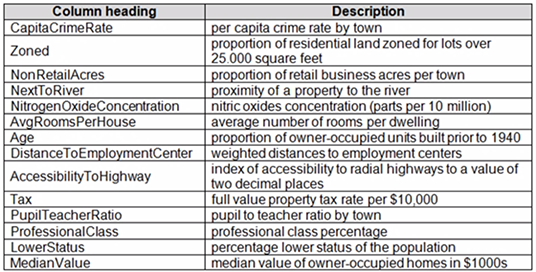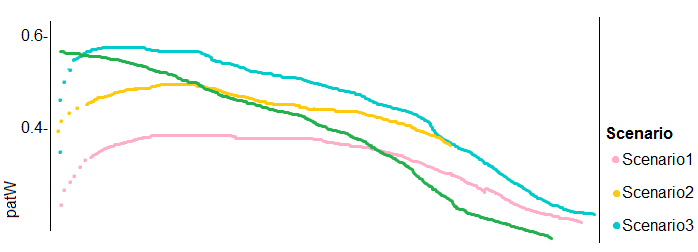DP-100: Designing and Implementing a Data Science Solution on Azure
You create a batch inference pipeline by using the Azure ML SDK. You run the pipeline by using the following code:
from azureml.pipeline.core import Pipeline from azureml.core.experiment import Experiment pipeline = Pipeline(workspace=ws, steps=[parallelrun_step]) pipeline_run = Experiment(ws, 'batch_pipeline').submit(pipeline)
You need to monitor the progress of the pipeline execution.
What are two possible ways to achieve this goal?

A
B
C
D
E
Answers are D and E
A batch inference job can take a long time to finish. This example monitors progress by using a Jupyter widget. You can also manage the job's progress by using:
- Azure Machine Learning Studio.
- Console output from the PipelineRun object.
from azureml.widgets import RunDetails
RunDetails(pipeline_run).show()
pipeline_run.wait_for_completion(show_output=True)
Reference:
https://docs.microsoft.com/en-us/azure/machine-learning/how-to-use-parallel-run-step#monitor-the-parallel-run-job
You train and register a model in your Azure Machine Learning workspace.
You must publish a pipeline that enables client applications to use the model for batch inferencing. You must use a pipeline with a single
ParallelRunStep step that runs a Python inferencing script to get predictions from the input data.
You need to create the inferencing script for the ParallelRunStep pipeline step.
Which two functions should you include?
run(mini_batch)
main()
batch()
init()
score(mini_batch)
Answers are run(mini_batch) and init()
Reference:
https://github.com/Azure/MachineLearningNotebooks/tree/master/how-to-use-azureml/machine-learning-pipelines/parallel-run
You plan to provision an Azure Machine Learning Basic edition workspace for a data science project.
You need to identify the tasks you will be able to perform in the workspace.
Which three tasks will you be able to perform?
Create a Compute Instance and use it to run code in Jupyter notebooks.
Create an Azure Kubernetes Service (AKS) inference cluster.
Use the designer to train a model by dragging and dropping pre-defined modules.
Create a tabular dataset that supports versioning.
Use the Automated Machine Learning user interface to train a model.
Answers are;
Create a Compute Instance and use it to run code in Jupyter notebooks.
Create an Azure Kubernetes Service (AKS) inference cluster.
Create a tabular dataset that supports versioning.
Reference:
https://azure.microsoft.com/en-us/pricing/details/machine-learning/
You use the Two-Class Neural Network module in Azure Machine Learning Studio to build a binary classification model. You use the Tune Model Hyperparameters module to tune accuracy for the model.
You need to select the hyperparameters that should be tuned using the Tune Model Hyperparameters module.
Which two hyperparameters should you use?
Number of hidden nodes
Learning Rate
The type of the normalizer
Number of learning iterations
Hidden layer specification
Answers are Number of learning iterations and Hidden layer specification
D: For Number of learning iterations, specify the maximum number of times the algorithm should process the training cases.
E: For Hidden layer specification, select the type of network architecture to create.
Between the input and output layers you can insert multiple hidden layers. Most predictive tasks can be accomplished easily with only one or a few hidden layers.
References:
https://docs.microsoft.com/en-us/azure/machine-learning/studio-module-reference/two-class-neural-network
You are creating a machine learning model. You have a dataset that contains null rows.
You need to use the Clean Missing Data module in Azure Machine Learning Studio to identify and resolve the null and missing data in the dataset.
Which parameter should you use?
Replace with mean
Remove entire column
Remove entire row
Hot Deck
Custom substitution value
Replace with mode
Answer is Remove entire row
Remove entire row: Completely removes any row in the dataset that has one or more missing values. This is useful if the missing value can be considered randomly missing.
References:
https://docs.microsoft.com/en-us/azure/machine-learning/studio-module-reference/clean-missing-data
Overview
You are a data scientist for Fabrikam Residences, a company specializing in quality private and commercial property in the United States. Fabrikam Residences is considering expanding into Europe and has asked you to investigate prices for private residences in major European cities.
You use Azure Machine Learning Studio to measure the median value of properties. You produce a regression model to predict property prices by using the Linear Regression and Bayesian Linear Regression modules.
Datasets
There are two datasets in CSV format that contain property details for two cities, London and Paris. You add both files to Azure Machine Learning Studio as separate datasets to the starting point for an experiment. Both datasets contain the following columns:

An initial investigation shows that the datasets are identical in structure apart from the MedianValue column. The smaller Paris dataset contains the MedianValue in text format, whereas the larger London dataset contains the MedianValue in numerical format.
Data issues
Missing values
The AccessibilityToHighway column in both datasets contains missing values. The missing data must be replaced with new data so that it is modeled conditionally using the other variables in the data before filling in the missing values.
Columns in each dataset contain missing and null values. The datasets also contain many outliers. The Age column has a high proportion of outliers. You need to remove the rows that have outliers in the Age column. The MedianValue and AvgRoomsInHouse columns both hold data in numeric format. You need to select a feature selection algorithm to analyze the relationship between the two columns in more detail.
Model fit
The model shows signs of overfitting. You need to produce a more refined regression model that reduces the overfitting.
Experiment requirements
You must set up the experiment to cross-validate the Linear Regression and Bayesian Linear Regression modules to evaluate performance. In each case, the predictor of the dataset is the column named MedianValue. You must ensure that the datatype of the MedianValue column of the Paris dataset matches the structure of the London dataset.
You must prioritize the columns of data for predicting the outcome. You must use non-parametric statistics to measure relationships.
You must use a feature selection algorithm to analyze the relationship between the MedianValue and AvgRoomsInHouse columns.
Model training
Permutation Feature Importance
Given a trained model and a test dataset, you must compute the Permutation Feature Importance scores of feature variables. You must be determined the absolute fit for the model.
Hyperparameters
You must configure hyperparameters in the model learning process to speed the learning phase. In addition, this configuration should cancel the lowest performing runs at each evaluation interval, thereby directing effort and resources towards models that are more likely to be successful.
You are concerned that the model might not efficiently use compute resources in hyperparameter tuning. You also are concerned that the model might prevent an increase in the overall tuning time. Therefore, must implement an early stopping criterion on models that provides savings without terminating promising jobs.
Testing
You must produce multiple partitions of a dataset based on sampling using the Partition and Sample module in Azure Machine Learning Studio.
Cross-validation
You must create three equal partitions for cross-validation. You must also configure the cross- validation process so that the rows in the test and training datasets are divided evenly by properties that are near each city’s main river. You must complete this task before the data goes through the sampling process.
Linear regression module
When you train a Linear Regression module, you must determine the best features to use in a model. You can choose standard metrics provided to measure performance before and after the feature importance process completes. The distribution of features across multiple training models must be consistent.
Data visualization
You need to provide the test results to the Fabrikam Residences team. You create data visualizations to aid in presenting the results.
You must produce a Receiver Operating Characteristic (ROC) curve to conduct a diagnostic test evaluation of the model. You need to select appropriate methods for producing the ROC curve in Azure Machine Learning Studio to compare the Two-Class Decision Forest and the Two-Class Decision Jungle modules with one another.
You need to correct the model fit issue. Which three actions should you perform in sequence?
Add the Ordinal Regression module
Add the Two-Class Averaged Perception module
Augment the data
Add the Bayesian Linear Regression module
Decrease the memory size for L-BFGS.
Add the Multiclass Decision Jungle module
Configure teh regularization weight
Step 1: Augment the data
Scenario: Columns in each dataset contain missing and null values. The datasets also contain many outliers.
Step 2: Add the Bayesian Linear Regression module.
Scenario: You produce a regression model to predict property prices by using the Linear Regression and Bayesian Linear Regression modules.
Step 3: Configure the regularization weight.
Regularization typically is used to avoid overfitting. For example, in L2 regularization weight, type the value to use as the weight for L2 regularization. We recommend that you use a non-zero value to avoid overfitting.
Scenario:
Model fit: The model shows signs of overfitting. You need to produce a more refined regression model that reduces the overfitting.
Incorrect Answers:
Multiclass Decision Jungle module: Decision jungles are a recent extension to decision forests. A decision jungle consists of an ensemble of decision directed acyclic graphs (DAGs).
L-BFGS: L-BFGS stands for "limited memory Broyden-Fletcher-Goldfarb-Shanno". It can be found in the wwo-Class Logistic Regression module, which is used to create a logistic regression model that can be used to predict two (and only two) outcomes.
References:
https://docs.microsoft.com/en-us/azure/machine-learning/studio-module-reference/linear-regression
Overview
You are a data scientist in a company that provides data science for professional sporting events. Models will use global and local market data to meet the following business goals:
Understand sentiment of mobile device users at sporting events based on audio from crowd reactions.
Assess a user’s tendency to respond to an advertisement.
Customize styles of ads served on mobile devices.
Use video to detect penalty events
Current environment
Media used for penalty event detection will be provided by consumer devices. Media may include images and videos captured during the sporting event and shared using social media. The images and videos will have varying sizes and formats.
The data available for model building comprises of seven years of sporting event media. The sporting event media includes; recorded video transcripts or radio commentary, and logs from related social media feeds captured during the sporting events.
Crowd sentiment will include audio recordings submitted by event attendees in both mono and stereo formats.
Penalty detection and sentiment
Data scientists must build an intelligent solution by using multiple machine learning models for penalty event detection.
Data scientists must build notebooks in a local environment using automatic feature engineering and model building in machine learning pipelines.
Notebooks must be deployed to retrain by using Spark instances with dynamic worker allocation. Notebooks must execute with the same code on new Spark instances to recode only the source of the data.
Global penalty detection models must be trained by using dynamic runtime graph computation during training.
Local penalty detection models must be written by using BrainScript.
Experiments for local crowd sentiment models must combine local penalty detection data.
Crowd sentiment models must identify known sounds such as cheers and known catch phrases. Individual crowd sentiment models will detect similar sounds.
All shared features for local models are continuous variables.
Shared features must use double precision. Subsequent layers must have aggregate running mean and standard deviation metrics available.
Advertisements
During the initial weeks in production, the following was observed:
Ad response rated declined. Drops were not consistent across ad styles. The distribution of features across training and production data are not consistent
Analysis shows that, of the 100 numeric features on user location and behavior, the 47 features that come from location sources are being used as raw features. A suggested experiment to remedy the bias and variance issue is to engineer 10 linearly uncorrelated features.
Initial data discovery shows a wide range of densities of target states in training data used for crowd sentiment models.
All penalty detection models show inference phases using a Stochastic Gradient Descent (SGD) are running too slow.
Audio samples show that the length of a catch phrase varies between 25%-47% depending on region The performance of the global penalty detection models shows lower variance but higher bias when comparing training and validation sets. Before implementing any feature changes, you must confirm the bias and variance using all training and validation cases.
Ad response models must be trained at the beginning of each event and applied during the sporting event.
Market segmentation models must optimize for similar ad response history.
Sampling must guarantee mutual and collective exclusively between local and global segmentation models that share the same features.
Local market segmentation models will be applied before determining a user’s propensity to respond to an advertisement.
Ad response models must support non-linear boundaries of features.
The ad propensity model uses a cut threshold is 0.45 and retrains occur if weighted Kappa deviated from 0.1 +/- 5%.
The ad propensity model uses cost factors shown in the following diagram:
| Actual | |||
| 1 | 0 | ||
| Predicted | 0 | 1 | 2 |
| 1 | 2 | 1 | |
The ad propensity model uses proposed cost factors shown in the following diagram:
| Actual | |||
| 1 | 0 | ||
| Predicted | 0 | 1 | 5 |
| 1 | 5 | 1 | |
Performance curves of current and proposed cost factor scenarios are shown in the following diagram:

You need to define an evaluation strategy for the crowd sentiment models.
Which three actions should you perform in sequence?
Define a cross-entropy function activation
Add cost functions for each target state
Evaluate the classification error metric
Evaluate the distance error metric
Add cost functions for each component metric
Define a sigmoid loss function activation
Step 1: Define a cross-entropy function activation
When using a neural network to perform classification and prediction, it is usually better to use cross-entropy error than classification error, and somewhat better to use cross-entropy error than mean squared error to evaluate the quality of the neural network.
Step 2: Add cost functions for each target state.
Step 3: Evaluated the distance error metric.
References:
https://www.analyticsvidhya.com/blog/2018/04/fundamentals-deep-learning-regularization-techniques/
You are using Azure Machine Learning to run an experiment that trains a classification model.
You want to use Hyperdrive to find parameters that optimize the AUC metric for the model. You configure a HyperDriveConfig for the experiment by running the following code:
hyperdrive = HyperDriveConfig(estimater=your_estimator, hyperparameter_sampling=your_params, policy=policy, primary_metric_name='AUC', primary_metric_goal=PrimaryMetricGoal.MAXIMIZE, max_total_runs=6, max_concurrent_runs=4)
You plan to use this configuration to run a script that trains a random forest model and then tests it with validation data.
The label values for the validation data are stored in a variable named y_test variable, and the predicted probabilities from the model are stored in a variable named y_predicted.
You need to add logging to the script to allow Hyperdrive to optimize hyperparameters for the AUC metric.
Solution: Run the following code:
from sklearn.metrics import roc_auc_score
import logging
# code to train model omitted
auc = roc_auc_score(y_test, y_predicted)
logging.info("AUC: " + str(auc))
Does the solution meet the goal?Yes
No
Answer is Yes
Python printing/logging example:
logging.info(message)
Destination: Driver logs, Azure Machine Learning designer
Reference:
https://docs.microsoft.com/en-us/azure/machine-learning/how-to-debug-pipelines